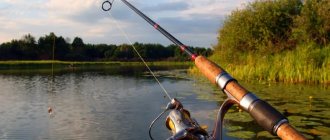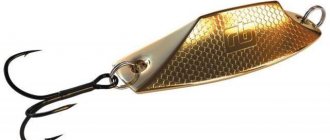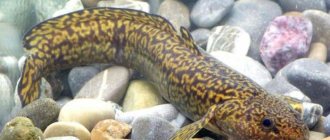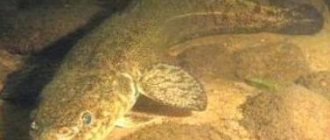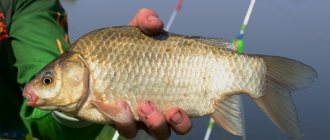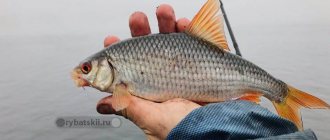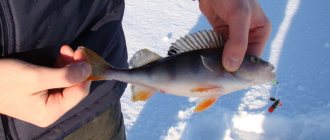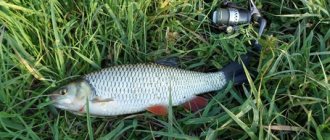The only freshwater representative of cod, burbot, is rarely encountered by spinning anglers. The peculiarities of the fish’s behavior lead to the fact that it is only occasionally found in bycatch, and very few anglers specifically go after burbot with a spinning rod. This is explained by sluggish biting during daylight hours, as well as other behavioral features. Such rare prey is a desirable trophy for a spinning fisher, so targeted fishing is still sometimes carried out, although the bycatch will often include pike perch, the night fishing of which is also popular and effective. Fishing for burbot with a spinning rod is also attractive because it shows maximum activity when other fish species are already preparing for winter - in late autumn, almost before the freeze-up.
Suitable spinning rod
Catching burbot with a spinning rod involves, first of all, fishing in the bottom layers of a reservoir, which means the best option would be jig. You need to select a fishing rod that meets not only the jig requirements, but also the fishing conditions. It is advisable to select the length based on the size of the reservoir and the distance of the points where fishing will be carried out. Since at night this representative of cod comes out to feed on the shallows located near the coastline, there is no need for long rods in such a situation. But conditions vary; places that are promising for fishing are often located at a considerable distance from the shore, which makes the use of forms 3 m or more long justified. The action is preferable to fast or very fast, because fishing is carried out mainly with silicone, foam rubber baits or wobblers with deep depth, and less often with various types of spinners. Fast-action forms are best suited for these types of artificial baits, allowing the use of a wide variety of retrieves. Test. This parameter also largely depends on fishing conditions and personal preferences. More often, burbot is caught on a spinning rod using relatively large baits, the length of which can be more than 9 cm, and eared sinkers or jig heads of the appropriate size will be needed for them. However, this is not a rule; you can successfully fish with ultralight, if such fishing is your favorite weight category in jig; autumn fishing can be effective using any weights.
It is also worth paying attention to the material used to make the handle - burbot is caught mainly in late autumn, which means that for fishing to be comfortable, the fisherman’s hands should not freeze to the rod. A light and warm cork handle is considered the best option for such conditions. Important! In conditions of limited visibility, casting accuracy is important, and this parameter depends not only on the rod, but also on the angler’s ability to feel his tackle.
The influence of weather conditions on the bite
Autumn burbot fishing requires taking into account weather conditions. Thus, it has been noted that fish bite best in rainy and windy weather. Fishing on a quiet night with a full moon will most likely result in failure. Another interesting point. When atmospheric pressure drops, most fish go into hibernation, but burbot, on the contrary, begins to show unprecedented activity.
Experienced fishermen know that burbot is attracted to the light of a bright fire. If there is one nearby, the probability of catching a valuable trophy increases several times. If you can’t light a flame, a flashlight will do just fine to attract the fish’s attention.
As already noted, burbot goes hunting at night - there is no point in catching it during the day. The first bursts of vital activity occur after sunset. The greatest success can be achieved between 10 pm and 2 am. With sunrise the biting stops abruptly.
And here's what you need to know: Buy a spinning rod for trout fishing
Coil selection
A spinning reel should be selected when the fishing rod has already been selected. For rods with a weight of 40, 50, or even 60 grams, you will need an equally powerful and reliable reel, which, although it will well withstand all the loads placed on it, will also cost a lot. When working with large weights, especially with frequent fishing, budget options may not withstand such operating conditions. For working with smaller weights (up to 30g) and cords or fishing lines of the same average diameter, budget solutions are quite suitable. The load here is significantly less, which means that a meat grinder with internal mechanisms made of inexpensive materials can cope with the task assigned to it. But in the lightest weight category everything is not so simple. With a line diameter of up to 0.4 according to the Japanese classification, budget reels work quite well, but as the diameter decreases, fishing ceases to be comfortable - beards and regularly dropped loops will ruin the whole fishing experience. Therefore, for ultra-thin braids, you will have to buy an expensive inertia-free cable that matches them in quality and cost.
Using edible silicone
For fishing in the bottom layers of a reservoir using artificial baits, maximum attention should be paid to edible silicone and foam fish - these baits are most suitable for autumn spinning fishing. Autumn burbot fishing with a spinning rod places special demands on the quality of edible rubber. First of all, this concerns the behavior of silicone bait at low temperatures. The problem is that many budget silicone options work quite well in warm water, but when the temperature drops, they lose their softness, elasticity, and therefore their play. Therefore, you need to use products that have been tested in cold conditions, because the lower the water temperature becomes, the more actively the burbot feeds. The color of the bait does not play a special role when fishing at night in autumn, although there are manufacturers that produce glow-in-the-dark options. But lovers of night fishing have not come to a clear conclusion about the light-accumulating elements on baits - some believe that they attract fish, while others believe that the glow only scares away aquatic inhabitants. When choosing silicone, preference should be given to active baits if you plan to fish at night, and take both active and passive options for daytime fishing. Daytime fishing in autumn becomes possible with the onset of the first night autumn frosts. At night, vibrations created by rubber are especially important - burbot does not see very well, especially at night, and relies more on the lateral line and sense of smell than on vision. This means it is better to choose baits that will be well felt by the side line - vibrotails, and to a lesser extent twisters. Passive rubber can also perform its task well, but the distance from which such silicone will be noticeable to burbot will be less than when using the same vibrating tails. A wide variety of rigs can be used; often the option used depends more on the preferences of the fisherman. However, it is better to pay attention first of all to options that are less prone to snagging, since autumn fishing for burbot usually takes place in very difficult areas of the bottom.
For burbot with a spinning rod
11/26/2014 Burbot, despite its unusual appearance, is a predator by nature and, just like pike or pike perch, is caught with a spinning rod and jig. Of course, there are differences, but they relate primarily to the time and place of fishing.
A certain difficulty when catching burbot is that for most of the year it practically does not show its presence in the reservoir. Even on the Oka, where, by all accounts, there is quite a lot of this fish, it is very difficult to say for sure whether it is in a particular place or not. Often you only become aware of its presence after an accidental capture.
COLD LOVER
I caught my first burbot on a spinning rod when I just started mastering fishing on the Oka River in the Beloomut area. There was nothing surprising in this, except that I caught it not in the fall, but in early spring, in March. The Oka differs significantly from other rivers near Moscow in that due to strong currents, ice does not appear here every winter. To do this, it is necessary that frosts remain below twenty degrees for some time. But even if there is strong ice, ice drift begins very early, and in March the ice melts away in any case. At this time, the water level rises slightly and a good, but short-lived bite of predators, including burbot, begins, and it is caught with equal success both on donkeys and on spinning rods.
And in the fall, its fishing usually resumes in early November, regardless of whether the autumn is cold or warm. There is an interesting pattern that can be clearly seen on the Oka: burbot begins to take bait with live bait or dead fish earlier than with a spinning rod. So when the first burbots appear in the local bottom fishermen’s catches, this means that in a week or two you should expect bites on your spinning rod.
UNDER THE SHORE AND IN THE SHALLOWS
It should be noted that bottom fishers on the Oka River provide some competition to spinning rods, blocking with their gear the most interesting places - entrances and exits - on coastal holes. But this is essential when fishing for pike and pike perch, but not for burbot. It is not so attached to sharp anomalies of the bottom topography, and it does not have permanent hunting grounds. Burbot almost always takes at shallow depths, somewhere up to two and a half, maximum three meters, prefers gently sloping coastal areas, spits, shallows, but always with a hard bottom. There are a lot of such places on the Oka, and in any of them a burbot bite is possible. In all this time, however, I have never managed to catch it under steep edges or far from the shore.
This year I had an unusual, but at the same time indicative case. On the shore I met fishermen who caught several medium-sized burbots using spinning rods, making maximum casts of seventy meters. This surprised me very much at first, and I didn’t immediately understand why I was taking the burbot at such a distance, and not closer to the shore, as usual. Everything was explained when I remembered that in this place, almost in the middle of the Oka, there was a sandbank with a dense bottom; The depth there is only a meter and a half. There are no pike perch or even perch on it, but the fishermen didn’t know this and threw it there - as a result, they caught several burbot instead of pike perch and perch.
I can’t say how it is in other reservoirs, but on the Oka, burbot is often caught literally right next to the shore. Last year, my friends and I, following the example of local fishermen, decided to catch it on donkeys with live bait. We cast straight in front of us at different distances, but there were no bites until the current washed all our gear right to the shore. At that time, the burbot was caught exclusively at a depth of only one meter.
The fact that burbot prefers to fish in shallow water presents a certain difficulty for spinning fishing. You have to either make short casts perpendicular to the shore, or lead the bait along the shore.
LURES AND LINES
Catching burbot with a spinning rod does not require special equipment; it practically does not pay attention to the thickness of the fishing line, but it does not take all baits; Wiring is also important. Jig fishing for burbot is not so popular that a large amount of information has accumulated about the most effective baits and types of fishing. I also can’t say that I devote a lot of time to it, but I was able to identify certain patterns.
Of the entire arsenal of jig baits, I was able to purposefully catch burbot with only two: a 5-centimeter greenish-gray vibrotail with sparkles and a crimson twister of almost the same size. If with regard to the first bait it can still be assumed that its color is similar to a small frog, then why the burbot takes the raspberry twister remains a mystery to me. With both of these baits, I first caught a couple of burbots purely by accident when catching pike at the first edge, and then I started using them specifically for burbot.
As for wiring, as I have repeatedly seen, burbot prefers the slowest one, when the bait drags along the bottom. You can lead the bait evenly, but it is better to periodically twitch it with the tip of the rod and take short pauses, while it is advisable not to tear it off the bottom. There is no bite as such for burbot, you just feel at some point that you are dragging something along the bottom. It feels like a bunch of grass is hanging on the bait. Not a single burbot was taken from me even with a weak blow. At the same time, he takes the bait greedily, swallowing it completely, and it is not clear when he manages to do this. Perhaps he manages to draw her in already during the fishing.
Burbot is a fairly strong fish, but after hooking it almost does not resist, but near the shore it often begins to persistently pull to the side. Of course, in terms of resistance it is far from pike, but in this respect it is even superior to pike perch.
Over the course of several years, I only had one case where the burbot got away. I brought it almost to the shore and saw that there was only a load in its mouth, and the bait was outside. If I had stood at the water's edge, I probably would have had time to catch it, but I was fishing from a cliff, and the burbot unhooked before I got down to the water.
WHEN?
Another question concerns fishing time. There is a widespread belief that burbot catches best at night. Perhaps this is so, but on the Oka River in the Beloomut area, it is at night that burbot bites are extremely rare, even on donkeys with fry. For this reason, local fishermen come to the river around three in the afternoon, fish until eight in the evening, and then leave. In addition to the evening outing, burbot also has a morning outing: the bite begins an hour or two before dawn and ends with sunrise.
It is difficult to say for sure when it is better to fish, in the morning or in the evening. On my last fishing trip, I caught two before dawn and two in the evening, while during the day I was fishing for pike perch. All the burbot was around a kilogram or a little more. The largest one caught this year weighed 2.6 kg. Moreover, as far as I can judge, larger burbot are caught on spinning rods than on donkeys.
I don’t think the ice on the Oka will freeze up any time soon, so spinners will still have time to catch this non-trivial fish to their heart’s content.
It is believed that burbots are inactive and do not feed in the warm season. This is apparently not the case. Finnish ichthyologists Paakkonen and Marjomäki fed experimental adult burbots with vendace at different temperatures. It turned out that with an increase in temperature from 2.4 to 14.4 degrees, the amount of vendace eaten by burbot per day increased. A decrease in appetite in burbots was observed only when the temperature reached 23 degrees.
How then can we explain the summer passivity of burbot? The fact is that, unlike other fish, the digestion of food in burbot takes longer, the warmer the water. The same portion of food is digested by burbot at a water temperature of 10 degrees in 4 days, and at a temperature of 20 degrees in 12 days. So, apparently, burbot can be caught in the summer months, it’s just that the probability of “catching” an active fish is very small.
We are on Google+ Fisherman-Fisherman
| Author | Nikolay Udovenko, Moscow |
| Issue number | 47/2014 |
| Read the article | 19334 |
Rating: 3.66
Spoons, wobblers and foam rubber
With good fishing skills, you can catch burbot in the bottom layers using rotating or oscillating spoons. True, such fishing has a number of problems. The lure needs to be driven as close to the bottom as possible, and with such a drive, not all models retain the game, and the likelihood of a snag is high. Therefore, spinners are rarely used for autumn fishing. Good results can be achieved by using wobblers with greater depth. Such baits are easy to recognize by their large blade. It is better to give preference to suspenders, since burbot prefers slow retrieves with pauses, but it is still advisable to have both sinking and floating models. Simple baits such as foam fish can also be catchy. In addition to the seductive game, such a fish has several other advantages. Firstly, foam fish are easy to make and you can make them yourself in large quantities. Secondly, the catchability of the bait can be enhanced by impregnating the foam rubber with an artificial or natural flavor. Thirdly, you can reduce the number of hooks by simply hiding the hook tips in the bait itself. Important! When fishing at night, it is advisable to have a supply of batteries for flashlights, since in cold weather the batteries discharge faster.
Jig spinning
Burbot On the cold, stormy days of autumn, sometimes in a total lack of bite, an angler can still warm the soul and fill the vacuum of fishing passion. And if there is also a hot fire nearby and good company, then all the hardships of a long night disappear, are erased, and only a black fish in the reflection of the fire and the faces of friends remain in the memory.
Now about the fish itself. Burbot is not found everywhere. It absolutely does not tolerate silted rivers with warm industrial wastewater, quarries, and ponds. But the clean rivers of the North-West and Siberia, deep flowing lakes are his element. Here it sometimes reaches gigantic sizes, sometimes up to 10-15. Some may think that catching burbot is not difficult at all. He threw the donkey, they say, at night, and just sit there...
However, without knowledge of burbot's habits, locations, feeding habits, tastes, there will be little chance of success. This article will discuss where to look for burbot, when and what to catch.
June July August
Contrary to popular belief, you can catch burbot in the summer, and where there is a lot of it, the chances of success are quite high.
Not so long ago, it was believed that with an increase in water temperature, burbot goes into hibernation, hiding under coastal cliffs, snags, tree roots, etc. However, observations by ichthyologists show that burbot leaves its shelter every night and often changes it. New burbots, instead of those caught, were found under shelters specially prepared for them - pieces of old slate. Moreover, such experiments were carried out on warm summer nights. More than once I had the opportunity to observe, while wandering through shallow water at night, how medium-sized burbots quickly retreat, frightened by the light of a lantern.
In fact, the behavior of burbot is determined by the water temperature - if it exceeds +15°-16°, then the migration of fish at night in search of food is extremely limited. On the other hand, in the rivers of Siberia, where the water is quite cold in the summer, catching burbot in the summer is a common occurrence.
Where to look for burbot
A) Flowing Lakes - On lakes like these, to be successful, you need to find areas with low water temperatures. And this is, first of all: 1) the exit points for the keys; 2) areas where rivers and streams flow into lakes (especially good if they are of spring origin or originate from swamps); 3) shallow waters, which cool much faster; 4) bottom cold horizons of deep lakes (see Fig. 1).
An almost mandatory condition for places where catching burbot is possible in summer is the presence of a sandy-pebble, sandy-rocky, sandy-clayey or slightly silty bottom. Moreover, the presence of rare aquatic vegetation is not an obstacle - most often these are reeds or horsetails.
A funny incident happened this summer on Nizhne-Posad Lake, which is part of the Morozov Lakes system, on the Karelian Isthmus. At about four in the morning I was catching roach from a boat, when I suddenly noticed that my wife, having put the fishing rod aside, began to quietly enter the sparse reeds in the shallow water. Then she rolled up her sleeves, took off her watch, froze... And then she tried to grab the unknown prey with both hands at once...
As it turned out later, she immediately noticed two small burbots standing almost next to each other. It was them that she tried, like a bird of prey, to snatch from the water. But, of course, without much success!
The time of day significantly affects the bite - with the onset of dusk and until about 24 hours, it is the best, weakens around two o'clock and then becomes active again in the pre-dawn hours.
The phases of the moon also have a significant impact on the burbot bite. During the full moon (especially if there are no clouds), the bite is the worst, and the best is when the moon is in the first or last quarter. During the new moon (1-2 days), when the moon is not visible at all, the bite, oddly enough, is weak.
Fishing methods
Spinning - although fishing at dusk and at night with a spinning rod is quite tedious, the results are sometimes very good. It is most convenient to use a rod with a length of 2 to 3 meters, with a dough of 20-40 grams. Any reel is suitable - spinning, multiplier, inertial.
It is most convenient to fish from the shore, in relatively shallow places, at depths of up to 2 meters, fishing the area according to the following scheme (see Fig. 2).
You can use oscillating and rotating spoons, but there is a high risk of snagging. It is much more convenient to fish with jig heads weighing from 10 to 20 g with a hook from No. 6 to No. 12, depending on the weight of the fish caught. A foam fish is put on the hook, which I pre-soak with the juice of crushed live bait. This measure is perhaps necessary, since burbot uses its sense of smell to a large extent when hunting at night. It is necessary to saturate the fish with live bait juice as often as possible (after 8-10 casts), since the juice and smell are quickly washed out.
The retrieving technique is slow, stepwise - cast, the jig head with foam rubber lies on the bottom, then 3-4 turns of the reel handle and pause, etc. It should be noted that where there is pike perch, it very often takes such a bait in parallel with the burbot. In addition to foam rubber, I also used live fish, but they quickly get worn out and fly off the hook of the jig head. Replanting a large crawler gives good results, but with the same wiring technique it usually takes a small burbot weighing 100-300
Onboard fishing rod - with this type of fishing, I already had the best results at great depths (from 2 to 4 meters). At the end of the nod made of a spiral spring there is a ball covered with luminous paint, clearly visible in the dark. Monofilament line with a diameter of 0.2 mm. Any reel, light, inertial.
The best bait is live bait: gudgeon, ruffe, roach. With this method of fishing, a sliding sinker of the “olive” type is placed 30-40 cm from the bait. The fishing technique is simple - smooth rises and falls of live bait 5-10 cm from the bottom. A fisherman in a boat drifts freely in the area where burbots are expected to be found. The bite is usually expressed in twitching nods, and then a weak pull. Despite its simplicity, this is one of the most effective ways to catch burbot during the open water season.
It is also good to use the above-mentioned jig head with bait bait, fry, worms, cuttings, bird guts, etc. The technique consists of smooth lifts and periodic tapping on the bottom. In the fall, when there is a problem with catching live bait, you can use both a foam “fish” and a twister. The use of even good spinners in the summer, with an abundance of natural baits and the presence of a relatively weak burbot bite, automatically fades into the background until the period of active feeding. Donks, girders, and anchored mugs with the attachments listed above also give excellent results, but these fishing methods can hardly be classified as sport fishing.
In the summer months, during the day, burbot bites are usually sporadic. In my practice, there were only bites on side fishing rods at a depth of 5 to 10 meters in cold water areas (as a rule, places where springs emerge).
B) Fishing in rivers - burbot sites are in many ways similar to flowing lakes, but here we must add the boundaries of oxbow lakes and the main channel, places with reverse flow, near dams, locks and bridges, sharp changes in depth (see Fig. 3).
Small burbots sometimes like to climb into rivers that can sometimes be jumped over. Here they stay in whirlpools or under steep banks. All that is required is the presence of a sandy bottom and cold, clean water. The weight of burbot in such rivers rarely exceeds 200-300 g and the best bait for them is a worm or whitebait.
September October November
As the water cools, the activity of burbot increases. It is increasingly encountered in the evening, late morning and even during the day. From the tributaries of rivers and lakes, small things roll down to winter and it is here, at the places where they flow into larger bodies of water, that burbot concentrates. Optimal depths are from 1.5 to 5 meters. Fishing methods are typical for the open water season, but here it is necessary to highlight the use of spinners when fishing with an onboard rod. The burbot spoon is not particularly sophisticated, but it should be light (5-15 g), deeply stamped and when playing, plan, moving away from the vertical axis by 15-20 cm. I usually hook a fry or its half with a tail. The fishing technique is as follows: a smooth rise from the bottom by 30-40 cm, and then a quick lowering of the whip. The bite feels like a soft hook. “Striking” the spoon along the bottom with periodic pauses also gives a good effect. You can also use another method - a large phosphorus jig with a hook from No. 6 to No. 10 is tied to a tee on a short section of line (5-6 cm), on which a tiny fry or the smallest worm is placed. The playing technique is the same. In this case, if the bite is bad, the burbot usually takes the jig, and if the bite is good, it “sits” on the tee (see figure).
December January February
During the period of ice cover formation and after about another week, burbot takes poorly. L.P. Sabaneev also described a similar phenomenon - burbot stands under the ice, in a state of shock, and local fishermen caught it by simply jamming it.
But having recovered from the freeze-up, sexually mature burbot rushes to the spawning grounds. And these are, again, shallow waters in the pre-estuarine areas and coastal zones with depths from 0.5 to 2 m with a sandy-pebble or rocky bottom. The period in December, a week or two before spawning, is the best time for catching burbot. From the ice, burbot is excellently caught using spoons and heavy jigs with or without bait. Moreover, before spawning it takes well during the day. In severe frosts it reaches the shallowest places with a depth of 0.5 m.
The moon phases mentioned above and clear weather with high pressure are favorable for biting. Optimal depths are from 1 to 3 m, in areas with good aeration and the lowest water temperature.
Spawning
Starting from the last ten days of December and the beginning of January, during spawning, burbot does not catch. The exception is small burbot up to 3 or 4 years of age, which can hardly be considered serious prey.
The eggs of the female are usually fertilized by 3 to 10 males, who are usually much smaller in size. Spawning occurs in the most severe frosts at a water temperature of about 0° and, as a rule, at night. The eggs are spawned at a depth of 0.5 to 2 meters and are very numerous (up to 3 million eggs).
It should be noted that in abnormally warm winters, spawning may not take place at all. In this case, the reproductive products in the burbot’s body gradually dissolve, replenishing to one degree or another the required level of proteins, the fish gets sick and the spring bite is weak. This phenomenon is typical for many species of living organisms, when, due to unfavorable factors, such as deterioration of the food supply, sudden changes in temperature, etc., reproductive functions are reduced, which often leads to a catastrophic decline in the population.
Under normal conditions, the spawning period for burbot usually lasts until mid-February, and in warm winters until early March.
March April May
In March - April, before the first edges appear, burbot is well caught near spawning sites at depths of 2 to 4 m, but as melt water begins to penetrate under the ice, it gradually moves to deeper areas. In March - early April, burbot can be caught well during the day.
The best baits during this period are small baitfish, whitebait, worms, cuttings (not frozen, as they lose their attractive smell).
Fishing methods: jigs, spoons, heavy jigs, foam rubber “fish” soaked in fish juice.
In the second half of April and May, with the beginning of ice destruction, burbot strikes mainly at night and late in the evening. The basis of nutrition during this period for small and medium-sized burbot is the caviar of early spawning fish. In lakes, burbot regularly visits shallows.
During the open water season, the diet of burbot in large reservoirs, such as Lake Ladoga, consists of smelt.
Gradually, with an increase in water temperature, burbot switches to a nocturnal feeding mode and moves to areas of reservoirs with an optimal water temperature for the summer season - no higher than 14°-15°, in order to repeat the life cycle that has developed over millions of years over and over again.
A. Mishin
"Sport fishing No. 01 - "
Tackle with dead fish
The effectiveness of such natural bait is especially high when predatory fish behave passively. The tackle is a fairly simple wire structure that secures a dead fish. Such a structure is loaded with an ordinary eared sinker. The hook used, as a rule, is one treble (although sometimes more hooks are used), which is threaded into the side of the fish with one of the stings. This design is carried out as slowly as possible so that the predator has time to smell the smell. The tackle is often used in situations where the predator ignores other baits.
Important! If the fish is fresh, just caught, its attractiveness to a predator can be increased by making several cuts on the side - predatory fish smell blood from a great distance.
Fishing place
Unlike the same pike perch or pike, finding burbot without knowing exactly its stopping and feeding places is extremely problematic. In the case of this fish, search fishing brings good results relatively rarely. Before going out specifically for burbot, you must either already have successful fishing experience in this place, or have fairly accurate information obtained from familiar anglers. Traces of fires on the shore can also serve as a guide to finding a fishing spot (unless it is a favorite picnic spot). If we talk about the places where burbot most likely lives, these will be rivers with clean water and constant recharge from cold springs. This fish prefers a rocky bottom, as it is easier to find shelter on it. Burbot can also be found in places where the roots of trees from a steep bank go under the water - this is also a good shelter for this fish. When fishing at night, you should pay attention not to the burbot’s camp sites, but to the shallows located not far from them, where the fish come out to look for food when night comes. If fishing takes place in late autumn, when the air temperature is already close to negative values, you can find burbot in almost any part of the reservoir - the fish is preparing for spawning, it has a glutton.
Catching burbot in the shallows
The little one was released.
Photo: Andrey Yanshevsky. A rather monotonous picture is now observed on reservoirs.
The small perch, which stay near the shore all winter, are joined by medium-sized fish that come from deep places.
It is quite likely that roaches are walking between the schools of perch.
And flocks of ruffed ruff came to the shallowest places near the shore.
It has been noticed that it is the ruff that now attracts the burbot, which approaches and stands next to the perch at the same depth and at the same distance from the coastal edge.
Well, if there is a sufficient amount of ruff in the reservoir, then finding it is not so difficult.
But the population numbers of ruffes experience obvious fluctuations from year to year, and quite significant ones at that.
Periodically, this fish is “attacked by pestilence” and it takes several years to restore the stock. Can't find the ruff. Then you need to look for pike.
The hunting grounds of burbot and pike throughout the winter very often coincide. It’s not for nothing that the common tactics of fishing with girders have proven themselves to be quite good, in which during the day the live bait swims in the water column, and at night the weight and bait are placed on the bottom.
The tactics for catching burbot in the absence of ruff are proven and simple, especially in those areas where fish forms part of the diet of local residents. First of all, it's work.
The point is to arrange as much gear as you can handle. This could be a hundred deliveries per fisherman. You need to catch live bait, make holes, arrange gear. During the day you need to check these gears.
| The old homemade girders turned out to be “eternal.” Photo: Evgeny Kuznetsov. |
It was another matter when the burbot approached the shore for a ruff. Fishing can become very exciting if you give up baiting and move on to active search and fishing with live bait using bottom equipment.
Read the material “In the fog on geese”
There are options here on what to choose as a live bait carrier. It could be a jig head, a large jig, not even necessarily large, but heavy. And, of course, the spinner.
You can attach a ruff to a jig hook in different ways - by the lip, by the back, by the tail, which depends on the hook, the size of the ruff and the fishing technique. I personally think that it is more effective to hook the bait on the back near the tail so that the ruff walks under the hole. By selecting a jig by weight, it is easy to limit or expand the area over which the baitfish moves.
You can attach live bait or cut bait to a jig head and play by tapping on the bottom, exactly as they do during the pre-spawning run of burbot in January. But now burbot does not have a clear path along which it migrates during the spawning periods. Now the burbots are distributed in a flock in ambushes over a fairly large area under the school of perch. Therefore, you not only have to make many holes, but also try to expand the search using moving live bait.
It is worth noting that the hunt for individual burbots is now underway. It is very rare that you can catch more than two fish from one hole.
If for one reason or another it is difficult to make many holes, or if the space on the ice for searching is limited, it makes sense to switch to a spinner, but it is better to do this when there has been at least one bite on a jig. It is noteworthy that the spinner should be noisy, rattling, knocking, as you like, that is, produce a powerful dull sound that spreads over many meters.
To do this, you can, for example, attach a weight with earflaps to the upper winding ring of the spinner. The point of this design is only that when the bait touches the bottom, it makes a clear sound. In this case, fishing tactics become significantly more sedentary. That is, you can sit over one hole and tap the bait on the bottom, in the hope that the burbot will become interested, come up and be tempted by the ruff on the hook.
It is difficult to predict how long to wait, since burbot can become active both at nine in the morning and at two in the afternoon.
Read the material “Spring fishing: farewell to winter”
Now is the time when, if you no longer want to go on the ice on a large body of water, you can catch burbot in a river where the ice has melted, but the flood has not yet arrived. The water has risen somewhat, but it is still clear and the current is not strong. The best days come when the ice has broken out and the water has subsided a little.
On an open river you need to look for places where small fish accumulate. Often such places are visible from the bleak, since both roach and gudgeon usually stand under it.
It must be taken into account that small fish stick to some places during the day and others at night. It is very difficult to predict the time of a predator's approach to the bait. It has been noticed that burbot, like large pike, is better caught in weather when fish of other species prefer not to be active.
That is, at a change in weather, in the rain, during strong winds. But with a full moon, a clear, quiet night, there will most likely be no bites. Although I had a case when a burbot pecked after lunch in a sky completely clear of clouds and a shining sun.
The gear is not elegant. As a rule, these are very simple in design equipment for fishing with bait lying on the bottom. Construct several “tricks” based on fishing line with a diameter of 0.3-0.5 mm, with a sliding sinker. Below the weight, tie or attach a leash made of fishing line with a diameter of 0.25-0.3 mm with a single hook No. 1-3. The tee will contribute to the “dead” hooks of the tackle.
Watching burbot bites is not at all necessary, although it is quite interesting. You can cast a donk and check it every half hour; if the burbot bites, it will simply swallow the bait and wait to be pulled ashore.
But it must be said that when pulled out, the burbot resists quite strongly and stubbornly, trying to catch its tail on some obstacle. The bite is very reminiscent of the ruff “twitching” of a jig in winter, or the summer bite of rotan. These are precisely the twitchings that can result in a classic stretch.
Read the material “Hunting through the eyes of an escort”
Small live bait is used as bait, attached to a hook by the lip. I consider ruffe and gudgeon to be the best live bait, that is, those species of fish that lead a bottom-dwelling lifestyle, although burbot often prefers small perch or even bleak. I see literary advice that the ruff’s spines should be cut off or its scales scraped off as not only inhumane, but also ineffective.
| It's a shame to have to suffer like this. Photo: Andrey Yanshevsky. |
Based on where the first bites occur, it makes sense to adjust all other gear to the distance and depth. But, if after some time the bites stop, you need to look for another level.
In the event that the first fish was caught while reaching the shallows, it is better to arrange the equipment along the area of the shallows or underwater spit, since the next bite can occur at any point in the selected area, and it is almost impossible to predict it.
That is, the tactics for catching burbot are continuous search and waiting. Echo sounders are not very helpful, since burbot literally crawls along the bottom with long stops.
Read the material “The last ice on an unfamiliar body of water: looking for fish”
Another thing is that with the help of an echo sounder it is easier to detect the hard and rocky bottom that this fish loves so much. And, of course, hidden from view, stones, branches and tree trunks lying at the bottom.
Often fishing in open spring water, for example in the Moscow region, continues until May. This year, the hunting period for burbot will be sharply reduced.
Andrey Yanshevsky March 11, 2021 at 10:35 am
Tactics and postings
Tactics depend primarily on the time of day.
If you are fishing at night, then first of all you should fish shallow waters near the burbot’s camp sites. If fishing takes place during the day, then it is better to pay maximum attention to fishing for the burbot’s favorite hiding places - deep-sea rocky areas of the bottom, holes with cold springs at the bottom. Although, if the activity of burbot has increased with the cold weather, this fish can be found in any part of the reservoir. You can and even need to make a fire on the shore. It will not only allow frozen fishermen to warm up, but will also attract burbot to the fishing spot with light. It was noticed that when fishing in autumn, the worse the weather, the higher the likelihood of an active bite and a good catch. Autumn fishing for burbot should be as slow as possible (especially when fishing at night), with long pauses. You can also slowly drag the bait along the bottom. During a pause, it’s a good idea to give the bait additional vibrations with the tip of the spinning rod. Source
Silicone baits and their characteristics
In order for autumn burbot fishing to be successful, you should learn as much as possible about this freshwater fish.
Burbot is a fish of the cod order with a narrow and long body, small eyes and a large mouth with several rows of sharp teeth. Some people confuse it with catfish, but if you look closely, you will notice that the burbot's whiskers are unpaired and are located on the chin.
The length of the fish reaches 1.2 meters, the approximate weight is 20-25 kg. Favorite habitats are deep areas of reservoirs with pebble or hard sand bottoms, riffles, snags, washed-out banks of river bends, rocky embankments where calm water and current coexist.
The active feeding phase begins at dusk. That is why the best time to catch burbot is at night.
The fish go to feed alone or in small groups, moving upstream. The colder the water, the bolder the burbot becomes.
He leaves secluded corners and goes out onto sandbanks, but still does not sail far from his “home.” Some people believe that burbot is easy to catch.
Actually this is not true. Only experienced and stubborn fishermen manage to quickly discover the location of this cautious fish.

